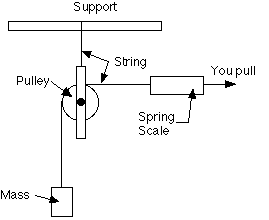A pulley is a simple machine consisting of a wheel turning on an axle. Pulleys are often used singly and in combinations to do work.
If energy is conserved for a machine, then the work done by the machine must be equal to the work put into the machine:
Work out = Work in
The work done by a pulley equals the weight it lifts, W (= mg), times the height it lifts it, h. The work that you put into the machine equals the Force that you exert on the string, F, times the distance that you pull the string, d. So, for an ideal pulley:
Fd = Wh (= mgh)
Of course, there is some friction present in any real pulley, so we would expect that some of the work that we put into the machine would be dissipated by friction (as heat energy, mostly). So for a real pulley,
Fd = Wh + Work done against friction
so,
The ratio of useful work done by the pulley (Wh) to the work you put in (Fd) is the efficiency of the pulley, which is usually expressed as a percent:
The mechanical advantage of a machine is the ratio of the output force to the input force, or:
Mechanical Advantage = W/F
|
2 single pulleys |
string |
|
0.5 kg & 1.0 kg masses |
spring scale |
|
ring-stand clamp |
c-clamp |
|
ring stand |
|
|
 |
|
Apparatus B - The pulley is tied to the weight being lifted |
|
|
|
|
|
|
Calculate the efficiency (work lifting the mass/work pulling the spring scale x 100%) and mechanical advantage (weight lifted/spring scale force) for one trial of apparatus A & B (and C if you did it). Answer the questions on the data table page.